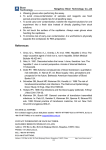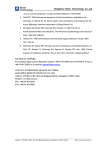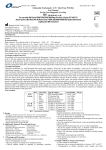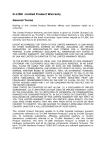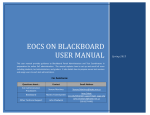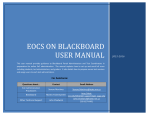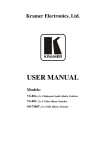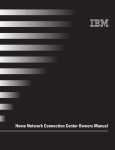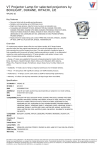Download Hangzhou Bioer Technology Co.,Ltd
Transcript
Hangzhou Bioer Technology Co.,Ltd TECHNICAL SUPPORT: For technical support, please dial phone number +86-571-87774567-5211 or 87774575, by fax to +86-571-87774553, or by email to [email protected]. CONTACT INFORMATION OF MANUFACTURER. HANGZHOU BIOER TECHNOLOGY CO.,LTD. Address: 1192 Bin An Rd., Hi-Tech (Binjiang) District, Hangzhou, 310053, China Website: www.bioer.com.cn. TEL: +86-571-87774575; FAX:+86-571-87774565. Address: 1192 Bin An Rd., Hi-Tech (Binjiang) District, Hangzhou, 310053, China 8/8 http://www.bioer.com.cn Hangzhou Bioer Technology Co.,Ltd PCR / RT-PCR Kit User’s Manual (20T) Cat# BSB02S1B For HCV PCR Fluorescence Quantitative Detection Address: 1192 Bin An Rd., Hi-Tech (Binjiang) District, Hangzhou, 310053, China 1/8 http://www.bioer.com.cn Hangzhou Bioer Technology Co.,Ltd 3 z Cap each tube and put the tube into a standard benchtop microcentrifuge. z Centrifuge at 700 × g for 5 s (3000 rpm in a standard benchtop microcentrifuge). Note: Place the centrifuge adapters in a balanced arrangement within the centrifuge. Place the PCR tube in the Real Time PCR Detection Instrument. 4 Cycle the samples as described in follows PCR amplification I (1 cycles, Analysis mode: None) Segment 1: 90℃,30s; Segment 2: 61℃,20min; 5 Segment 3:95℃,1min; PCR amplification Ⅱ ( 50 cycles, Analysis mode: Single(FAM&HEX)) Segment 1: 95℃,15s; Segment 2: 60℃,60s; In the Edit Sample Screen define the site containing the HCV standards 1-4 as “standard”, and enter the respective concentrations, provided with the kit in the lot-specific information. Make sure, all other samples are defined as “unknown”. 6 Note: More detailed information on options of the Edit Sample Screen is given in the Real Time PCR Detection Instrument Operator's Manual. Result analysis and judgments Perform data analysis, as described in the Real Time PCR Detection Instrument Operator’s Manual. Analysis method Use of the Fit points method. This renders the method independent from user-born influences. Quality Control 1. The Ct value of the Negative control must be ∞. 2. The Correlation of standard curve must be ≤-0.98. 3. The Ct value of the Internal control must be <40. 4. The Ct value of the positive control must be <35. Note 1. This kit is for research use only. 2. Before you begin, you should read this user’s manual carefully. 3. Prepare appropriate aliquots of the kit solutions and keep them separate from other reagents in the laboratory. Address: 1192 Bin An Rd., Hi-Tech (Binjiang) District, Hangzhou, 310053, China 6/8 http://www.bioer.com.cn Hangzhou Bioer Technology Co.,Ltd Ingredients Ingredients Volume Quantity Sample BIOZOL-total RNA Extraction reagent 5ml 1 Tube(s) ⑴ 500ul 1 Tube(s) ⑵ RT-PCR MIX Mn2+ 50ul 1 Tube(s) ⑶ HCV Probe Mix 30ul 1 Tube(s) ⑷ DEPC H2O 1ml 1 Tube(s) ⑸ Internal control 50ul 1 Tube(s) ⑹ Negative control 200ul 1 Tube(s) ⑺ Positive control 200ul 1 Tube(s) ⑻ Standard control 1: 5.0×107copies/ml 100ul 1 Tube(s) ⑼ Standard control 2: 5.0×106copies/ml ⑽ ⑾ 100ul 1 Tube(s) 5 100ul 1 Tube(s) 4 100ul 1 Tube(s) Standard control 3: 5.0×10 copies/ml Standard control 4: 5.0×10 copies/ml Applied instrument Line-Gene Series Real-time PCR detection system. Storage and period of validity Except for BIOZOL-total RNA Extraction reagent store at 4℃,the others store at -20℃. The kit can be stored for up to 12 months if all components are kept in the manner above. Additional required reagents and equipment 1. Chloroform, isopropanol, 75% ethanol, Nuclease-free aerosol-preventive pipette tips. 2. Sterile centrifuge (Eppendorf) tube for preparing, 0.2 ml real-time PCR tube. 3. Pre-cool the high-speed centrifuge containing a rotor for 2.0 ml reaction tubes and rotor to 2~8℃. Specimen Collection and Storage 1. EDTA, CPD, CPDA-1, CP2D, ACD-A and 4% Sodium Citrate may be used with this kit. Address: 1192 Bin An Rd., Hi-Tech (Binjiang) District, Hangzhou, 310053, China 3/8 http://www.bioer.com.cn Hangzhou Bioer Technology Co.,Ltd 2. Blood collected in EDTA may be stored at 2~30℃ for up to 72 hours from time of draw, followed by an additional two days at 2~8℃. For storage longer than five days, remove the plasma from the red blood cells by centrifugation at 800~1600xg for 20 minutes. Following removal, plasma may be stored at 2~8℃ for an additional seven days. Alternatively, plasma may be stored at -18℃ for up to one month. 3. Blood collected in CPD, CPDA-1, or CP2D may be stored for up to 72 hours at1~24℃. Following centrifugation of the CPD, CPDA-1, or CP2D samples at 800-1600xg for 20 minutes, plasma may be stored at 1~6℃ for an additional 7 days from the date the plasma was removed from the red blood cells. Plasma separated from the cells may be stored at-18℃ for up to one month. 4. ACD-A or 4% sodium citrate anticoagulated apheresis plasma can be stored at 1~6℃ for up to 6 hours, followed by subsequent storage at-18℃ for up to one month. 5. Do not freeze whole blood. 6. Heparin has been shown to inhibit PCR. Use of heparinized specimens is not recommended. 7. Warm pooled or individual donor specimens to room temperature before using. 8. Covered Archive Plates may be stored at 2 – 8°C for up to 7 days from the date the plasma was removed from the red blood cells. 9. No adverse effect on assay performance was observed when plasma specimens were subjected to three freeze-thaw cycles. 10. Thaw frozen specimens at room temperature before using. 11. The user should validate other collection and storage conditions. If specimens are to be shipped, they should be packaged and labeled in compliance with applicable federal and international regulations covering the transport of clinical specimens and etiologic agents.10 12. False positive results may occur if cross contamination of specimens is not adequately controlled during specimen handling and processing. Protocol 1. Specimen, Control and External Standard Control Preparation 1.1 Add 200ul of BIOZOL-total RNA Extraction reagent to a 0.5ml centrifuge tube; 1.2 Prepare 50ul of serum sample (include Specimen, ⑺Positive Control, and ⑹Negative Control) into the 0.5ml centrifuge tube, and vortex; 1.3 Add 50ul of Chloroform into the centrifuge tube and invert the tube 10 times to Address: 1192 Bin An Rd., Hi-Tech (Binjiang) District, Hangzhou, 310053, China 4/8 http://www.bioer.com.cn Hangzhou Bioer Technology Co.,Ltd mix (Do not vortex); 1.4 Centrifuge at 12,000g for 15min at 4℃; 1.5 Transfer the aqueous phase* to a new 0.5ml centrifuge tube (RNase free); *Important: Don’t touch the middle phase. 1.6 Add 200ul of isopropyl alcohol, invert the tube 10 times to mix; 1.7 Centrifuge at 12,000 g for 15 minutes at 4℃; 1.8 Spill the supernatant and add 400ul of 75% ethanol into the centrifuge tube, invert the tube 5 times to mix; 1.9 Centrifuge at 12,000 g for 5 minutes at 4and completely remove** the supernatant again; ** Spill the supernatant and fast spin the tube again, then use a new pipette tips to discard the supernatant. 1.10 Airs dry the RNA deposition 5 minutes and add 25ul of ⑷DEPC H2O to dissolve; 2 PCR reaction mixtures prepare: Define the experimental protocol before preparing the solutions. Calculate the number of reactions needed plus one additional reaction for the HCV RT-PCR MIX Proceed as described below for a 50 ul standard reaction when preparing the reaction mixtures. Step Action Preparation of the master mixes: Note: The volumes indicated below are based on a single 50ul standard reaction. Prepare HCV RT-PCR MIX by multiplying the amount in the “Volume” column by the number of reactions to be cycled, plus one additional reaction. It is recommended preparing a mixture containing RT-PCR MIX, Mn2+, HCV Probe Mix , and Internal 1 control , in a 1.5ml tube first, before dividing the mixture in separate PCR tube and adding the Detection RNA sample Mixes. The volumes per tube are mentioned below: Component Volume 2 ⑴ ⑵ ⑶ ⑸ RT-PCR MIX Mn2+ HCV Probe Mix Internal control 25.0 ul 2.5ul 1.5ul 1.0ul z Mix gently, and pipette 30ul master mix into the corresponding Real-time PCR tube. z Add 20 ul of the corresponding HCV RNA template (Specimen; control). z Add 20 ul of the standards control 1 to 4. Address: 1192 Bin An Rd., Hi-Tech (Binjiang) District, Hangzhou, 310053, China 5/8 http://www.bioer.com.cn Hangzhou Bioer Technology Co.,Ltd Preface Hepatitis C Virus is considered to be the principal etiologic agent responsible for 90-95% of the cases of post-transfusion non-A and non-B hepatitis.1,2 HCV is a single-stranded, positive sense RNA virus with a genome of approximately 10,000 nucleotides coding for 3,000 amino acids.1 As a blood-borne virus, HCV can be transmitted by blood and blood products. The global prevalence of HCV infection, as determined by immunoserology, ranges from 0.6% in Canada to 1.5% in Japan.2 Serological screening assays have greatly reduced, but not completely eliminated, the risk of transmitting viral infections by transfusion of blood products3-6. Recent studies indicate that nucleic acid-based amplification tests for HCV RNA will allow detection of HCV infection earlier than the current antibody based tests. Nucleic acid testing of whole blood donations has been in place in the United States since 1999 under Investigational New Drug Application. Nucleic acid-based tests can detect the units of virus donated by carriers who do not seroconvert or who lack antibodies to serological markers normally detected by immunological assays. This fluorescence Detection Kit is adapted for many kinds of Real Time PCR Detection Instrument., specifically adapted for Line-Gene I&II Real-time PCR Detection System. HCV RNA is reverse transcribed and a specific fragment is amplified with specific primers in a one-step RT-PCR reaction. The products are detected by using a specific Taqman-MGB Probes. This Taqman-MGB Probes is labeled at the 5’-end with FAM report dye, and the 3’-end by NFQ(Non Fluorescent Quencher)-MGB. An Internal Control is supplied. This allows the user both to control the RNA isolation procedure and to check for possible PCR inhibition. For this application, add 10ul the Internal Control to the isolation per sample. Address: 1192 Bin An Rd., Hi-Tech (Binjiang) District, Hangzhou, 310053, China 2/8 http://www.bioer.com.cn Hangzhou Bioer Technology Co.,Ltd 4. The use of nuclease-free lab ware (e.g. pipettes, pipette tips, reactions 5. 6. 7. 8. 9. vials)as well as Wearing gloves when performing the assay. To avoid cross-contamination of samples and reagents use fresh aerosol-preventive pipette tips for all pipetting steps. To avoid carry-over contamination, transfer the required solutions for one experiment into a fresh tube instead of directly pipetting from stock solutions. Do not touch the surface of the capillaries. Always wear gloves when handling the capillaries. To minimize risk of carry-over contamination, it is worthwhile to physically separate the workplaces for RNA preparation. References 1. Choo, Q-L., Weiner, A.J., Overby, L.R. et al. 1990. Hepatitis C Virus: The major causative agent of viral non-a, non-b hepatitis. British Medical Bulletin 46:423-441. 2. Alter, H. 1991. Descartes before the horse: I clone, therefore I am: The hepatitis C virus in current perspective. Annals of Internal Medicine 115:644-649. 3. Dodd RY. 1994 Adverse consequences of blood transfusion: quantitative risk estimates. In: Nance ST, ed. Blood supply: risks, perceptions and prospects for the future. Bethesda: American Association of Blood Banks1-24. 4. Schreiber GB, Busch MP, Kleinman SH, Korelitz JJ. 1996 The risk of transfusiontransmitted viral infections. The Retrovirus Epidemiology Donor Study. N Engl J Med 334:1685-90. 5. Holland PV. 1996 Viral infections and the blood supply (editorial). N Engl J Med 334:1734-35. 6. Kleinman SH, Busch MP. General overview of transfusion transmitted infections. In: Petz LD, Swisher S, Kleinman SH, Spence R, Strauss RG, eds. 1995 Clinical practice of transfusion medicine, 3rd ed. New York: Churchill Livingstone 809-21. Address: 1192 Bin An Rd., Hi-Tech (Binjiang) District, Hangzhou, 310053, China 7/8 http://www.bioer.com.cn








